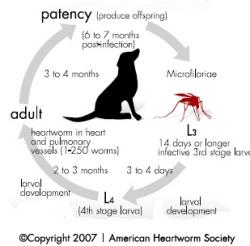Dog Heartworm Disease

We want to help you keep your pet healthy, so you should know about dog heartworm disease.
Disease
Mosquitos transmit heartworms from pet to pet when they feed. The larval stages develop in the bloodstream into adult worms that live in the heart and pulmonary vessels, in the lungs. Heartworm preventative kills off the larval stage before it develops into the adult worm.
Diagnosis
Antigen test looks in the blood for the presence of female heartworms. It takes 6 to 7 months for the microfilariae to develop into an adult and the test will only show a positive result when they are adults. Microfilariae tests look for microfilariae in the blood, about 30% of positive dogs will show microfilariae. This depends on the severity of the infection. Imaging diagnostics like thoracic radiographs will show structural changes caused by heartworms. They cannot determine if the pet is positive or negative as the structural changes are irreversible. This is due to the inflammation of the vessels and dilation of the heart caused by the heartworms.
Treatment
The recommended treatment is the split-dose protocol or also known as the "fast kill" protocol. The Patient starts out on a monthly Heartworm preventative to halt the development of more heartworms. They will continue this for the rest of their life. During the first month, they will be on Doxycycline or Minocycline to weaken the adult heartworms. Then they will be given a dose of Melarsomine to kill off the weak and older heartworm after they finish the Doxycycline or Minocycline. They will also start on steroids to decrease inflammation. A month later, they will get two doses of Melarsomine 24 hours apart to kill the remaining heartworms. Throughout this protocol and 6 weeks after the last dose of Melarsomine, they will need to be on strict rest.
The other treatment option is called the "slow kill" protocol, which is not recommended by the American Heartworm Society. The difference in this treatment plan is that you do not give any doses of Melarsomine. The patient is still put on monthly heartworm preventative and given Doxycycline or Minocycline. This weakens the adult heartworms, shortens their life expectancy, and prevents new heartworms from forming. The average heartworm lives 5 to 7 years. The patient needs to be strictly rested until tested negative for heartworms.
There are no "natural" or herbal therapies shown to be safe and effective prevention or treatment for heartworm disease.
Differences
The "fast kill" protocol usually takes 4 to 5 months while the "slow kill" protocol could last between 2 to 7 years. The patient needs to be on bed rest during the entire protocol so the "fast kill" protocol will have the patient back to normal activity sooner. Also, the "fast kill" protocol is shorter; there is less time for irreversible damage to the heart, lungs, and pulmonary vessels to occur. The "slow kill" protocol is initially cheaper but could become more expensive depending on the duration of the treatment and if other issues arise due to the presents of heartworms.





